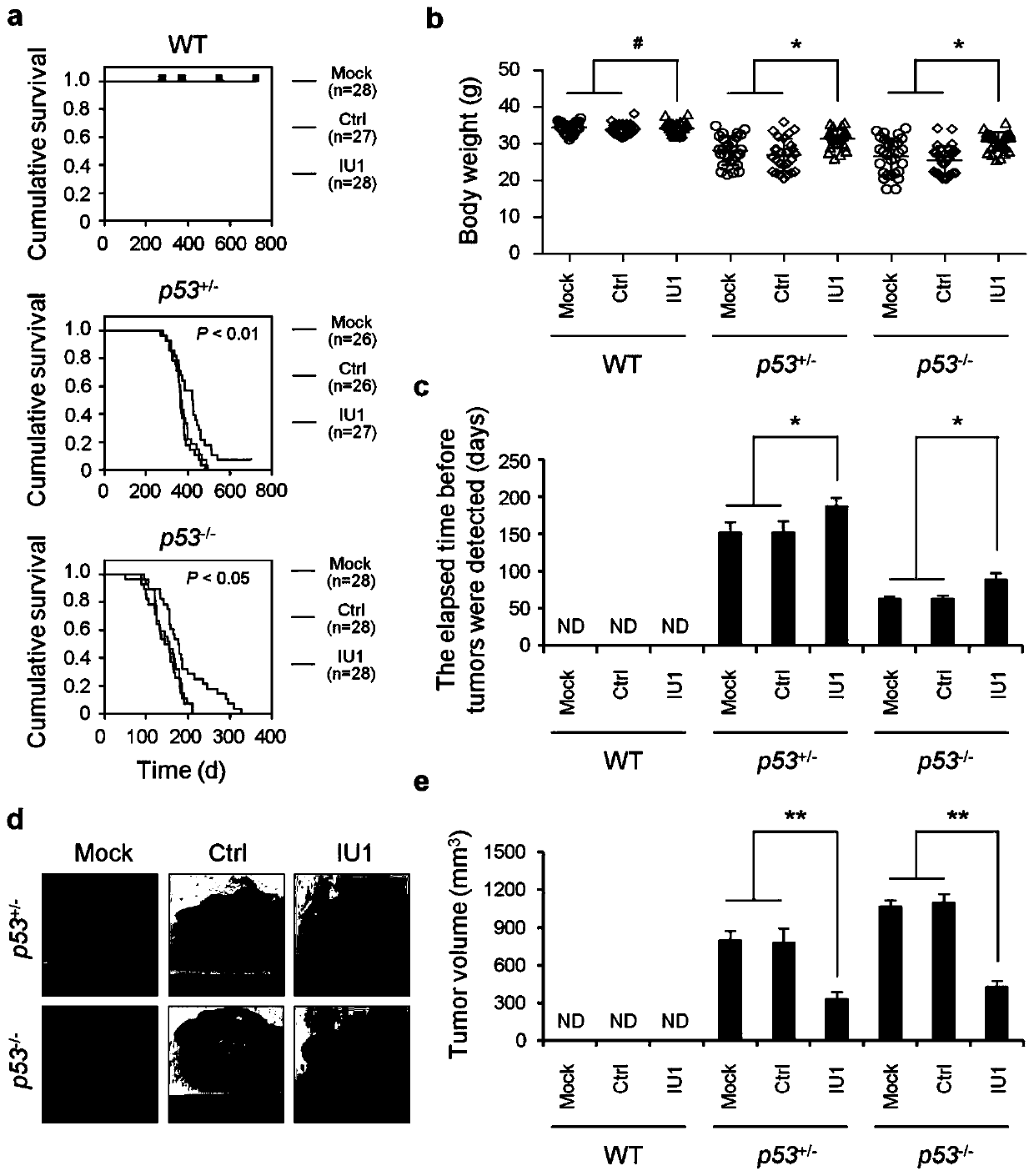Application of IU1 in preparing drugs for treating p53-deficient tumors
A defect, tumor technology, applied in the field of tumor drugs, can solve problems such as difficulty in obtaining clinical efficacy
- Summary
- Abstract
- Description
- Claims
- Application Information
AI Technical Summary
Problems solved by technology
Method used
Image
Examples
Embodiment 1
[0022] Spontaneous tumor formation and the therapeutic effect of IU1 were observed with p53 heterozygous knockout mice and p53 homozygous knockout mice.
[0023] All experimental procedures were approved by the guidelines of the Animal Care and Use Committee (IACUC) of Tongji University School of Medicine (SYDW-19-215). Experiments were performed in 9-month-old wild-type and p53 heterozygous knockout (p53+ / -) mice and 3-month-old p53 homozygous knockout (p53- / -) mice. Genomic DNA from tail biopsies was genotyped using Trp53-based polymerase chain reaction (PCR). The reaction system of PCR is as follows:
[0024]
[0025] Among them, oIMR7777 5'ACAGCGTGGTGGTACCTTAT3' (SEQ ID No.1);
[0026] oIMR7778 5'TATACTCAGAGCCGGCCT3' (SEQ ID No. 2);
[0027] oIMR8306 5'CTATCAGGACATAGCGTTGG3' (SEQ ID No. 3).
[0028] The PCR amplification procedure is as follows:
[0029]
[0030]
[0031] Mice were treated by intraperitoneal injection twice a week. The main components of the...
Embodiment 2
[0035] Imaging analysis of IU1 inhibits the number and type of tumors generated in p53 gene homozygous deficient mice
[0036] Utilize conventional X-ray, MICRO-CT and MRI to analyze the location, quantity and type of mouse tumors.
[0037] The result is as figure 2 shown. figure 2 X-ray, MICRO-CT and MRI analysis and typing of primary tumors in p53 gene homozygous deficient mice. p53 gene homozygous deficient mouse MLT ( figure 2 -A), p53 gene homozygous deficient mouse STS ( figure 2 -B) and p53 gene homozygous deficient mouse OSA ( figure 2 -C) X-ray, MICRO-CT and MRI analysis. figure 2 -D is the effect of IU1 on the number of cancer types in wild type, p53 heterozygous knockout mice and p53 homozygous knockout mice. figure 2 -E is the number of mice with MLT or OSA in p53 heterozygous knockout mice and p53 homozygous knockout mice. CTRL, control group; MLT, thymic malignant lymphoma; MOCK, untreated mice; NA, not applicable; OSA, osteosarcoma; STS, soft tissu...
Embodiment 3
[0040] The molecular mechanism of IU1 tumor suppressor was verified by primary cancer cells and tumor tissues of mice spontaneously forming tumors
[0041] Mouse spontaneous tumorigenic primary cancer cells were cultured in DMEM medium containing 10% (V / V) fetal bovine serum (FBS), 100 μg / ml penicillin, and 100 mg / ml streptomycin, and flow cytometry was performed. Experiments analyzing the effect of IU1 on the cell cycle and distribution in p53 heterozygous knockout mice.
[0042] Conventional Western blotting analysis was used to detect the protein levels of cell cycle, senescence and apoptosis-related markers in p53 heterozygous knockout mice.
[0043] The detailed experimental steps are as follows: use the lysate to lyse the tissue sample, and use the BCA protein concentration assay kit to measure the protein concentration of the sample. Add an appropriate amount of concentrated SDS-PAGE protein loading buffer to the collected protein samples. Heat at 100°C or in a boilin...
PUM
 Login to View More
Login to View More Abstract
Description
Claims
Application Information
 Login to View More
Login to View More - R&D
- Intellectual Property
- Life Sciences
- Materials
- Tech Scout
- Unparalleled Data Quality
- Higher Quality Content
- 60% Fewer Hallucinations
Browse by: Latest US Patents, China's latest patents, Technical Efficacy Thesaurus, Application Domain, Technology Topic, Popular Technical Reports.
© 2025 PatSnap. All rights reserved.Legal|Privacy policy|Modern Slavery Act Transparency Statement|Sitemap|About US| Contact US: help@patsnap.com



